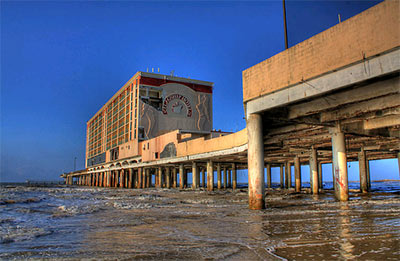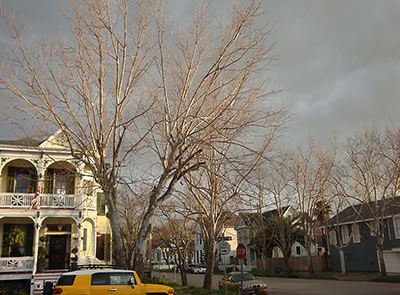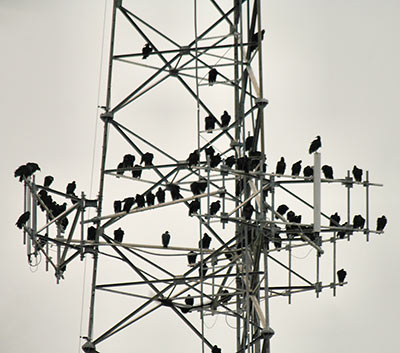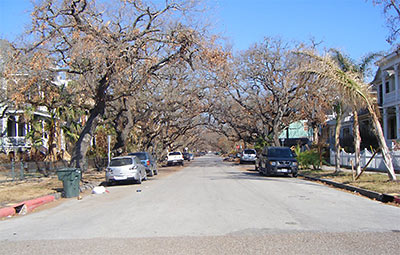COMMENT OF THE DAY: GALVESTON OFFSHORE PLATFORM ECO-GAMBLING ESCAPES “. . . a ‘Santa Monica’ pier at The Flagship location would be golden, would be the DESTINATION for a lot of folks! But couldn’t there ALSO be an offshore gambling venue?? Imagine an elevator takes gamblers to a secret bullet-train in a tube, which whisks them to an oil derrick with gaming (no horse-racing, of course, haha!) The Island needs an injection of edgy intrigue since The Balinese is gone. Also, George Mitchell is another Player on Galveston; the gambling train could offer eco-tours to see Gulf habitat and thus receive some federal matching funds or something…” [movocelot, commenting on Roller Coaster on the Pier: Crunch Time for the Flagship Hotel]
Tag: Galveston
THE PASSING OF THE SAN LUIS PASS Galveston will . . . survive! “‘The current predictions for sea level are that it will rise somewhere between two feet and three feet over the next century,’ said [Rice University Oceanographer and Geologist John] Anderson. ‘I think most scientists would agree from about Jamaica Beach west will probably disappear by the end of this century.'” [11 News]

There may be a buyer for Galveston’s Flagship Hotel, reports Laura Elder in the Galveston County Daily News. The hotel suffered about $7 million in damage from Hurricane Ike last year. But Landry’s Restaurants, the current owner, has a fallback plan in case the sale doesn’t go through:
If the 225-room property at 25th Street and Seawall Boulevard doesn’t sell, Landry’s likely would demolish the hotel and develop a “pleasure pier†with amusement rides, officials say. . . .
Landry’s is pricing demolition for the hotel, built in 1965 as a show of confidence after Hurricane Carla, Jeff Cantwell, senior vice president for development, said.
Perched on a pier overlooking the Gulf, the Flagship fell into disrepair on its own after 1990, when The Flagship Hotel Ltd. took over management.
Landry’s paid the city $500,000 for the hotel in 2004, saying it planned to spend $15 million transforming the property into an entertainment plaza with amusement rides, including a roller coaster.
Landry’s attempted to move ahead, but was stymied by agreements that gave Daniel Yeh, head of The Flagship Hotel Ltd., control of the hotel until 2031.

Salt water from Hurricane Ike damaged 11,000 trees on city property in Galveston — and as many as 31,000 more on private property will need to be cut down. The Chronicle‘s Allan Turner reports:
The process will involve a tree-by-tree examination, the Texas Forest Service’s Pete Smith said. Candidates for cutting will include most tree varieties that have lost 50 percent or more of their canopy. Live oaks with at least 30 percent of their leaves may be spared. The live oaks, Smith said, are “either recovering or dying,†and more time is needed to determine which is the case.
Officials hope to remove doomed trees [on city property] by the middle of September, thereby qualifying for federal payments that could cover up to 75 percent of the city’s removal cost.
. . . Removing every dead tree on both public and private land could cost about $5 million, according to city estimates, although the federal government will pay to remove only those in the city right of way.
- Thousands of dead trees to be removed soon [Houston Chronicle]
- Previously in Swamplot: Galveston for Tourists: Not Quite Yet
Photo: Flickr user lutzman–
Here’s the latest version of the trailer for Ike: A Documentary: The Story of a Torn City Rebuilt by Everyday Heroes. The movie was created by students in Mr. Weiss’s film class at Galveston’s Ball High School.
It all began on the first day of school after the hurricane as students sat together in the advanced media technology class and talked about their storm experiences.
Some students had lost everything. Austin [Almanza]’s family lost their house. William [Gomez] got separated from his family and spent the storm at the high school, which became an emergency shelter during the storm.
As they discussed the storm, “I posed the question,†Weiss recalled. “Do you think we should do a documentary about this?â€
- A project close to their hearts [Houston Chronicle]
- Our Story [Ike Documentary]
- New trailer for “IKE: A DOCUMENTARY” [YouTube]

A few fun pics from around and about town! First, this crowd of black vultures ponders its next real-estate venture from atop a communications tower parked in a gated community in Cypress. Photographer Karen Morris happened upon the scene on Eldridge near Grant Rd.:
It was an awesome sight. Personally, if they adorned my rooftop every evening, I’d clean the roof, sell the house and move to the other side of town. . . . Black Vultures/Buzzards are a bit smaller and less colorful that the Turkey Vulture. They tend to follow the Turkey Vulture because it has a keener sense of smell and can find it’s meal through use of that sense. They eat dead animals and occasionally capture small live animals (field mice, etc.). Although they do not build a nest, they will take an abandoned nest. Often roost together as seen in this set of photos. If startled while roosting, they will regurgitate with power and accuracy.
More local habitat:
THE END OF GALVESTON AS WE KNEW IT John Nova Lomax tours the unsung wreckage from Hurricane Ike: “In Galveston, the progress looks superficially impressive. Scaled-back and/or rescheduled editions of major tourist draws like Dickens on the Strand and the Lone Star Biker Rally went over fairly well. Things seem to be getting back to normal, and here in Houston, the second our power came back on, the lines dwindled at the corner gas station and the streetlights returned to working order, most of us ‘moved on.’ Hasn’t Galveston as well? In a word, no.” [Houston Press]
A LINE IN THE VANISHED SAND Galveston Planning Commissioner Chula Ross Sanchez, surveying damaged properties on the island 3 months after after Hurricane Ike: “The General Land Office (GLO) has drawn a new line in the sand four-and-half feet above sea level. People can stabilize their properties on the beach but we cannot issue new construction certificates in that zone. The line is normally based on vegetation but the storm wiped that out and the new line is based on mean sea levels. Drawing that line, many houses have ended up on public property.” [OffCite]
HURRICANES: THE DEVIL GALVESTON WILL KNOW IN ADVANCE The brand spanking new Galveston National Laboratory, which will be home to the world’s nastiest bacteria and most infectious viruses, officially opens next week. “Yes, at first blush it seems daft to build a nearly $200 million facility with the world’s deadliest biologicals in hurricane country. But the reality strikes me quite differently. In fact, there’s an advantage that comes from being able to know a couple days in advance of a hurricane’s threat. This offers time to lock down the lab, which simply wouldn’t be possible in an area threatened by tornadoes or earthquakes.” [SciGuy]

Sure, we’ve all heard about the damage to Galveston — from news reports and the sad tales of returning residents. But how’s the place looking to tourists? Lou Minatti took his kids for a visit over the weekend:
The island is in sad shape. But there were some bright spots. The Moody Gardens Aquarium is open, and since there are so few tourists they have greatly reduced the entrance fee. (The Rain Forest Pyramid is closed until further notice.) The kids did get to see a beautiful shrimp trawler up close. They were fascinated.
What struck me most was the fact that all of the trees are dead. All of the beautiful live oaks, planted soon after the 1900 hurricane, are no more. They were killed by the flood of salt water. The only trees to survive are the palms and Norfolk Island pines. My best guess is that every deciduous tree more than 5 blocks from the seawall is dead.

FEMA-approved colors liven up this property-damage-assessment map for 24,000 structures in Galveston.
The red areas are “unsafe; leaning; structurally unsound; completely destroyed; collapsed or structure missing.”
Yellow means “general interior flooding; wind damage; or significantly damaged, but repairable.”
And green means go! “No damage or only minor damage; or missing siding; shingles; handrails; breakaway walls.”
The gray areas? “Flood zone.”
More colorful maps of other Hurricane-Ike-hit areas of the city are available on the City of Galveston website.
- Damage Assessment Map for Areas 61st Street East, 61st Street West to Jamaica Beach, and Jamaica Beach West to San Luis Pass as of 10/15/08 [City of Galveston, via Hair Balls]
- City Releases Damage Assessment Map & Issues Guidance for Property Owners [City of Galveston]
MIDSUMMER BOOKS: 8 FEET IS ENOUGH This fall was the final season for Midsummer Books, near the Strand in Galveston: “‘All those shops and restaurants on Strand, Mechanic and Postoffice were hit bad, and Midsummer Books got 8 ft of muddy water which soaked and ruined everything, books, furniture, computer equipment, etc.,’ owner Tim Thompson says by e-mail. ‘Luckily I have flood insurance so I will most likely get compensated for the loss. However, this is one of those times in life where tough decisions have to be made and for a variety of reasons I have decided not to ressurect Midsummer Books,’ he says.” [Hair Balls]
SHOULD GALVESTON BE REBUILT? “The city and its environs rest on barrier islands, which are made of sand, low-lying and prone to significant geological shifts. In Galveston’s case, even before Ike’s landfall, the island was both sinking slowly and becoming sharply eroded along its west end. Moreover, a couple of years ago, the city itself commissioned University of Texas geologist Jim Gibeaut to create a geohazards map for the island, that is, where should development not occur? The research study found that nearly all the development along the beach front west of the seawall, which protects the core of the island, is in ‘red’ or ‘yellow’ zones, where Gibeaut says development should not occur.” [SciGuy]
THOUSANDS LOST THEIR HOMES. HOW MANY LOST THEIR LAND? With all the beach erosion, coastal homeowners may find their homes now sit on public property: “Even people whose coastal houses were spared by Hurricane Ike could see them condemned under a little-known Texas law, and hundreds whose beachfront homes were wrecked could be barred from rebuilding there. Now here’s the saltwater in the wound: It could be a year before the state tells these homeowners what they may or may not do. And if these homeowners do lose their beachfront property, they may get no compensation from the state.” [L.A. Times]
GALVESTON AFTER THE SECOND GREAT HURRICANE
“My sense is that Galveston will come back as a weekender community and a modest tourist vista, but that commerce not related to the tourism industry will continue to decline at an accelerated rate. My sense is that what we might see in 20 years is a community comprised of a few high-rise condos and resorts along the seawall, the ubiquitous weekender homes on the West Beach and not much else. It will certainly be easier to evacuate such a community.” [Houston’s Clear Thinkers]

